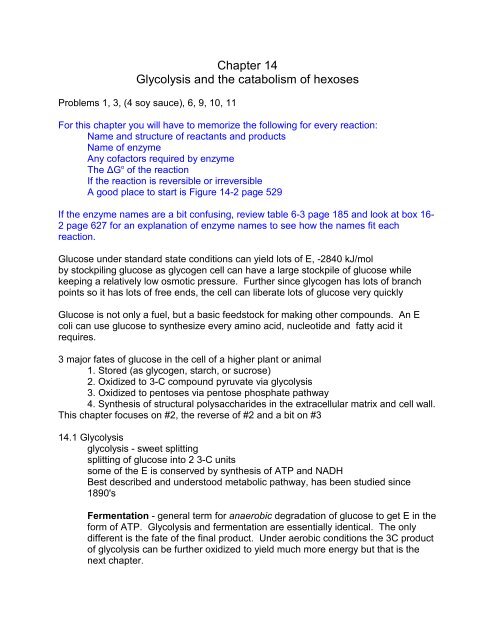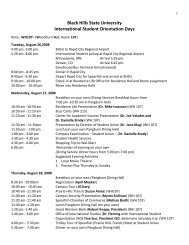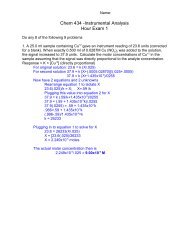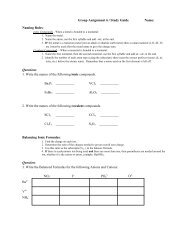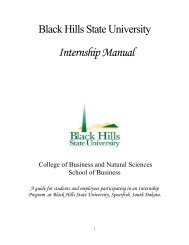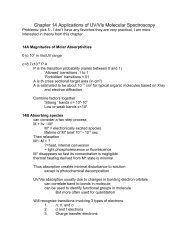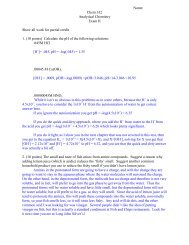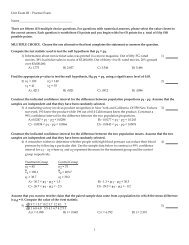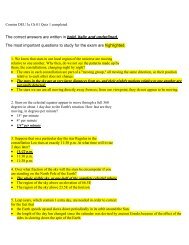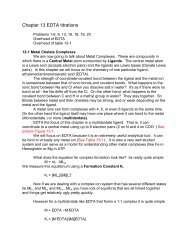Chapter 14 Glycolysis and the catabolism of hexoses
Chapter 14 Glycolysis and the catabolism of hexoses
Chapter 14 Glycolysis and the catabolism of hexoses
You also want an ePaper? Increase the reach of your titles
YUMPU automatically turns print PDFs into web optimized ePapers that Google loves.
<strong>Chapter</strong> <strong>14</strong><br />
<strong>Glycolysis</strong> <strong>and</strong> <strong>the</strong> <strong>catabolism</strong> <strong>of</strong> <strong>hexoses</strong><br />
Problems 1, 3, (4 soy sauce), 6, 9, 10, 11<br />
For this chapter you will have to memorize <strong>the</strong> following for every reaction:<br />
Name <strong>and</strong> structure <strong>of</strong> reactants <strong>and</strong> products<br />
Name <strong>of</strong> enzyme<br />
Any c<strong>of</strong>actors required by enzyme<br />
o<br />
The ÄG <strong>of</strong> <strong>the</strong> reaction<br />
If <strong>the</strong> reaction is reversible or irreversible<br />
A good place to start is Figure <strong>14</strong>-2 page 529<br />
If <strong>the</strong> enzyme names are a bit confusing, review table 6-3 page 185 <strong>and</strong> look at box 16-<br />
2 page 627 for an explanation <strong>of</strong> enzyme names to see how <strong>the</strong> names fit each<br />
reaction.<br />
Glucose under st<strong>and</strong>ard state conditions can yield lots <strong>of</strong> E, -2840 kJ/mol<br />
by stockpiling glucose as glycogen cell can have a large stockpile <strong>of</strong> glucose while<br />
keeping a relatively low osmotic pressure. Fur<strong>the</strong>r since glycogen has lots <strong>of</strong> branch<br />
points so it has lots <strong>of</strong> free ends, <strong>the</strong> cell can liberate lots <strong>of</strong> glucose very quickly<br />
Glucose is not only a fuel, but a basic feedstock for making o<strong>the</strong>r compounds. An E<br />
coli can use glucose to syn<strong>the</strong>size every amino acid, nucleotide <strong>and</strong> fatty acid it<br />
requires.<br />
3 major fates <strong>of</strong> glucose in <strong>the</strong> cell <strong>of</strong> a higher plant or animal<br />
1. Stored (as glycogen, starch, or sucrose)<br />
2. Oxidized to 3-C compound pyruvate via glycolysis<br />
3. Oxidized to pentoses via pentose phosphate pathway<br />
4. Syn<strong>the</strong>sis <strong>of</strong> structural polysaccharides in <strong>the</strong> extracellular matrix <strong>and</strong> cell wall.<br />
This chapter focuses on #2, <strong>the</strong> reverse <strong>of</strong> #2 <strong>and</strong> a bit on #3<br />
<strong>14</strong>.1 <strong>Glycolysis</strong><br />
glycolysis - sweet splitting<br />
splitting <strong>of</strong> glucose into 2 3-C units<br />
some <strong>of</strong> <strong>the</strong> E is conserved by syn<strong>the</strong>sis <strong>of</strong> ATP <strong>and</strong> NADH<br />
Best described <strong>and</strong> understood metabolic pathway, has been studied since<br />
1890's<br />
Fermentation - general term for anaerobic degradation <strong>of</strong> glucose to get E in <strong>the</strong><br />
form <strong>of</strong> ATP. <strong>Glycolysis</strong> <strong>and</strong> fermentation are essentially identical. The only<br />
different is <strong>the</strong> fate <strong>of</strong> <strong>the</strong> final product. Under aerobic conditions <strong>the</strong> 3C product<br />
<strong>of</strong> glycolysis can be fur<strong>the</strong>r oxidized to yield much more energy but that is <strong>the</strong><br />
next chapter.
2<br />
Since early atmosphere didn’t contain O 2 so oxidation could not occur. This is<br />
probably <strong>the</strong> most primitive biological mech for getting E from sugars<br />
Yet this pathway is strongly conserved. Enzyme structures are essentially <strong>the</strong><br />
same between you <strong>and</strong> yeast or spinach. The only differences are in <strong>the</strong> fine<br />
tuning <strong>of</strong> controls<br />
A. Overview - 2 phases <strong>of</strong> glycolysis<br />
Figure <strong>14</strong>-2<br />
Total <strong>of</strong> 10 reactions<br />
first 5 are preparatory, breaking glucose into 3C units<br />
Cost 2 ATP to phosphorylate <strong>the</strong> sugar in <strong>the</strong> process<br />
last 5 are energy yielding<br />
1 NADH <strong>and</strong> 2 ATP are formed from each 3C unit<br />
thus overall cost is<br />
-2ATP +2 NADH + 4 ATP<br />
For a net <strong>of</strong> 2NADH <strong>and</strong> 2 ATP/1glucose2 pyruvate<br />
depending on organism <strong>and</strong> conditions <strong>the</strong>re are 3 fates for <strong>the</strong> pyruvate<br />
at <strong>the</strong> end <strong>of</strong> glycolysis<br />
1. In aerobic organisms under aerobic conditions<br />
Pyruvate (CH3COCOOH) oxidized to acetate, acetate fur<strong>the</strong>r<br />
oxidized to CO 2 in citric acid cycle <strong>Chapter</strong> 16 in<br />
mitochondria to generate NADH <strong>and</strong> FADH used to pump<br />
proton, out <strong>of</strong> mito, <strong>the</strong>n protons allowed back in to generate<br />
ATP (chapter 19)<br />
2. In aerobic organism under anaerobic conditions (like in muscle<br />
when you haven’t caught your breath)<br />
Run out <strong>of</strong> NADH. Can’t stop ATP syn<strong>the</strong>sis just because<br />
ran out <strong>of</strong> NADH, so use NADH to turn pyruvate to<br />
(CH3COCOOH) to lactic acid (CH3CHOHCOOH) lower net E<br />
yield, but allows process to continue. That is why you build<br />
up lactic acid in muscle<br />
This process is also done in certain tissues, (brain, retina,<br />
erythrocytes)<br />
3. In certain plant tissues, invertebrates, protist under anaerobic<br />
conditions<br />
Turn in ethanol (fermentation)<br />
Overall E<br />
Net reaction <strong>the</strong>n is:<br />
+<br />
Glucose + 2NAD + 2ADP + 2P i <br />
+<br />
2 pyruvate + 2 NADH + 2H + 2ATP + 2H O<br />
2
3<br />
Can separate into two processes<br />
Exergonic<br />
+ +<br />
Glucose + 2NAD 2 pyruvate + 2 NADH + 2H +<br />
ÄG=-<strong>14</strong>6 kJ/mol<br />
Endergonic<br />
2ADP + 2P i 2ATP + 2H2O<br />
ÄG= + 61 kJ/mol (2 x 30.5)<br />
Net ÄG= - 85 kJ/mol<br />
So will go forward<br />
And is so strongly pulled forward that is essentially<br />
irreversible<br />
Is only about 40% efficient (61/<strong>14</strong>6)<br />
Total E<br />
At this point have recovered a fraction <strong>of</strong> total E. Can get lots more<br />
from total oxidation <strong>of</strong> pyruvate to CO (<strong>Chapter</strong> 16 & 19)<br />
Importance <strong>of</strong> phosphorlylated intermediates<br />
All 9 glycolytic intermediates are phosphorylated - this has imprtant<br />
implications:<br />
1. No transporters for phosphorylated intermediates, so cannot<br />
leave cell.<br />
2.Watch as chemistry around phosphate changes energy <strong>of</strong> linkage<br />
until high enough energy to make ATP<br />
3. Binding energy <strong>of</strong> phosphate group to active site on enzyme<br />
2+<br />
lowers activation energy <strong>of</strong> <strong>the</strong> respective reactions. Also Mg is<br />
usually required to bind ATP,ADP, <strong>and</strong> many <strong>of</strong> <strong>the</strong>se<br />
phosphorylated intermediates so you will see as a c<strong>of</strong>actor in many<br />
<strong>of</strong> <strong>the</strong> enzymes<br />
2
4<br />
B. Preparatory reactions (<strong>the</strong> first 6)<br />
1. Phosphorylation <strong>of</strong> glucose<br />
o<br />
ÄG = -16.7 kJ/mole<br />
this is big E drop so irreversible<br />
catalyzed by enzyme hexokinase<br />
-<br />
(Kinase Enzyme that transfers a PO 4 from NTP to acceptor molecule)<br />
Called hexokinase because will also work with fructose <strong>and</strong><br />
mannose<br />
2+ 2+<br />
absolute requirement for Mg for binding <strong>of</strong> ATPMg<br />
Back in chapter 8 used this as an example <strong>of</strong> induced fit because big<br />
change in structure when substrate binds<br />
is a soluble cytosolic protein (although may be part <strong>of</strong> a complex)<br />
Will see later that a step that is both irreversible <strong>and</strong> initial commit step is<br />
a great place for regulation<br />
Hexokinase is present in nearly all organisms<br />
Humans have 4 different hexokinases from 4 different genes (I,II,III,IV)<br />
Different enzymes that perform same reaction are called isozymes<br />
Often involved in different kinds <strong>of</strong> control in different tissues
5<br />
2. Conversion <strong>of</strong> Glu-6-P to Fru-6-P<br />
Enzyme: phophohexose isomerase (phosphoglucose isomerase)<br />
(Isomerase transfers groups within a molecule to change isomeric form)<br />
Mechanism Figure <strong>14</strong>-4<br />
o<br />
ÄG ’ = 1.7 so near equilibrium, <strong>and</strong> reversible<br />
requires Mg 2+<br />
3. Phosphorylation <strong>of</strong> F-6-P to F 1,6-bisP<br />
Enzyme : phoph<strong>of</strong>ructokinase -1 (PFK-1)<br />
-<br />
(Kinase again, PO 4 from ATP to acceptor)<br />
o<br />
ÄG ’ = -<strong>14</strong>.2 kJ so strongly favored <strong>and</strong> irreversible<br />
There is a phosph<strong>of</strong>ructokinase -2<br />
Won’t see until chapter 15 - just mentioning now<br />
PFK-1 again a major E drop <strong>and</strong> major commit point so is under heavy<br />
regulation<br />
perhaps <strong>the</strong> most complex regulation known<br />
Activity if ADP or AMP are in excess<br />
Inhibited if excess ATP<br />
More later
Also note naming convention:<br />
bisphospho - means 2 phosphates attached at different places<br />
diphosphate - means a 2-phosphate group attached at a single place (like ADP)<br />
trisphosphate means 3 phosphates at different positions (1,4,5-trisphophate<br />
triphosphate 3 phosphates attached at one place (ATP)<br />
4. Cleavage <strong>of</strong> fructose 1,6-Biphosphate<br />
6<br />
Enzyme: aldolase<br />
(Trivial name, not systematic reverse <strong>of</strong> an aldol condensation)<br />
o<br />
ÄG ’ = 23.8 kJ/mol highly unfavorable but still reversible<br />
next 2 steps rapid so little accumulation <strong>of</strong> product, so keeps going<br />
forward<br />
Mechanism Figure <strong>14</strong>-5<br />
review reaction <strong>of</strong> amine with aldehyde to make imine<br />
In vertebrates do not need divalent ion, but in many microorganism need Zn 2+<br />
because use a different mechanism<br />
See figure <strong>14</strong>-6 for numbering <strong>of</strong> C through this reaction<br />
5. Interconversion <strong>of</strong> trioses<br />
Enzyme: Triose phosphate isomerase<br />
(Isomerase, internal transfer <strong>of</strong> a group to change isomer)<br />
o<br />
ÄG ’ = + 7.5 kJ so not terribly favorable<br />
See figure <strong>14</strong>-6
7<br />
C1 now = C6<br />
C2 = C5<br />
C3 = C4<br />
Finished prep <strong>of</strong> glucose, now ready to start making E<br />
C. The Pay<strong>of</strong>f phase<br />
6. Oxidation <strong>of</strong> glyceraldehyde 3-phosphate to 1,3-Bisphosphoglycerate<br />
Enzyme: glyceraldehyde 3-phosphate dehydrogenase<br />
(Dehydrogenase trivial name for an oxidoreductase that removes hydrogen)<br />
o<br />
ÄG ’ =6.3 kJ/mol so slightly unfavored<br />
Final product contains mixed anhydride or acyl phosphate<br />
very high E substance<br />
Mech is fairly complicated<br />
See figure <strong>14</strong>-7<br />
step 1&2 SH for protein adds across aldehyde<br />
(Just like OH does to make hemiacetal but technically thiohemiacetal)<br />
Substrate covalent attached - covalent catalysis<br />
-<br />
step 3 - 1 H remove as H (a pair <strong>of</strong> electrons)<br />
Thus removing electrons from substrate, <strong>and</strong> making an oxidation<br />
The hydride is actually transferred to NAD +<br />
Step 4 NADH now leaves enzyme<br />
Phosphate comes in <strong>and</strong> nucleophillic attack on C=O<br />
Step 5 collapsed product leaves, <strong>and</strong> SH regenerated<br />
Cell contains limited amount <strong>of</strong> NAD so will grind to a halt here if not<br />
+<br />
regenerated<br />
(Will see how in a minute)
8<br />
+<br />
First enz to use NAD so lets look at this c<strong>of</strong>actor in a bit more detail<br />
+ +<br />
NAD /NADH <strong>and</strong>/or NADP /NADPH<br />
From 516-519 <strong>of</strong> text<br />
Nicotinamide adenine dinucleotide NAD +<br />
figure 13-24 from text<br />
difference between NAD <strong>and</strong> NADP is extra phosphate on c2<br />
vitamin form niacin (nicotinic acid)<br />
FYI nicotine<br />
Lack <strong>of</strong> Niacin causes disease pellagra - diarrhea, dermatitis, dementia<br />
seen in rural South in early 1900's<br />
not a true vitamin, can be syn<strong>the</strong>sized from tryptophan<br />
diet <strong>of</strong> mostly corn, low in tryp, so missing precursor<br />
interestingly corn is rich in niacin, but it is tied up <strong>and</strong> not available in<br />
digestion<br />
Unless corn soaked in base solution... Hominy!!<br />
+<br />
Note: look at structure, what is charge on NAD -2+1 = -1<br />
+<br />
<strong>the</strong> + in NAD indicates only <strong>the</strong> charge on <strong>the</strong> base, not that whole molecule, is<br />
mostly a reminder that is in oxidized form<br />
+ +<br />
so NAD NADP refers to oxidized forms, NADH <strong>and</strong> NADPH refers to reduced forms<br />
NAD <strong>and</strong> NADP generic term if you don’t care if oxidized or reduced<br />
NAD/NADP always involved in 2 electron reactions involving a hydride ion( H:) -<br />
change ins structure shown in figure<br />
In most enzymes reaction is stereospecific, <strong>and</strong> H will add from one side or <strong>the</strong> o<strong>the</strong>r<br />
but not both<br />
Net reaction<br />
+ - + +<br />
NAD(P) + 2e + 2H NAD(P)H + H<br />
+<br />
(Technically H is a spectator but will always see as product in biological<br />
reactions)
9<br />
UV characterizes change when oxidized or reduced Make it easy to follow reaction if<br />
have a spectrophotometer that goes into UV (as saw in labs last semester)<br />
-5<br />
Total conc. NAD + NADH is about 10 molar<br />
-6<br />
Total conc. NADP/NADPH 10 molar<br />
Since chemically almost identical, reduction potential <strong>of</strong> NAD <strong>and</strong> NADP is essential <strong>the</strong><br />
same, YET<br />
+<br />
NAD /NADH couple is used extensively in catabolic metabolism, that is, oxidizing things<br />
to get E,<br />
+ +<br />
[NAD ]/[NADH] large ([NAD ] high) so reaction driven to right,<br />
+<br />
NADP /NADPH is used extensively in anabolic metabolism, that is reducing things that<br />
were oxidized into new useful compound.<br />
+<br />
[NADP ]/[NADP] is very low, ([NADPH] high) so reaction driven to left<br />
most enzymes will use one form but not <strong>the</strong> o<strong>the</strong>r<br />
this keeps anabolic metabolism separate from catabolic so don’t get futile cycles<br />
association between NAD <strong>and</strong> enzyme is very loose, so in most mechanisms NAD is<br />
bound in one step <strong>and</strong> <strong>the</strong>n released in ano<strong>the</strong>r. NAD s a soluble way to move<br />
electrons around in <strong>the</strong> aqueous cytosol <strong>of</strong> a cell.
10<br />
Returning to metabolism<br />
7. Phosphoryl transfer from 1,3-Bisphosphoglycerate to ADP<br />
Enzyme: phophoglycerate kinase<br />
o<br />
ÄG ’ = -18.5 kJ big E drop<br />
note name kinase, name actually refers to reverse reaction! Does <strong>the</strong> reverse<br />
reaction in photosyn<strong>the</strong>sis but not in glycolysis<br />
Large E drop here used to pull previous reaction or three along<br />
+ +<br />
Glyceraldehyde 3-phosphate + NAD 1,3-bisphosphoglycerate + NADH + H +6.3<br />
1,3-bisphosphoglycerate + ADP 3-Phosphoglycerate + ATP -18.5<br />
NET:<br />
+ +<br />
Glyceraldehyde 3-phosphate + NAD +ADP 3-Phosphoglycerate + ATP+ NADH + H<br />
Plus some E left over to pull even more this way<br />
-12.2<br />
Syn<strong>the</strong>sis <strong>of</strong> ATP by direct transfer <strong>of</strong> a phosphate group from <strong>the</strong> substrate<br />
called<br />
substrate-level phosphorylation<br />
as opposed to respiration- linked phosphorylation that we will see later in<br />
respiration
11<br />
8. Conversion <strong>of</strong> 3-Phosphoglycerate to 2-Phosphoglycerate<br />
Enzyme: phosphoglycerate mutase<br />
(mutase - trivial name for an isomerase)<br />
o<br />
ÄG ’= 4.4 kJ reversible<br />
Enzyme has an interesting mechanism. Instead <strong>of</strong> simply moving <strong>the</strong> phosphate<br />
from one OH to <strong>the</strong> o<strong>the</strong>r what actually happens is this:<br />
Figure <strong>14</strong>-8<br />
The enzyme contains a Phosphorylated His<br />
this phosphate is attached to make 2,3- biphophoglycerate<br />
<strong>the</strong> original phosphate at <strong>the</strong> 3 position is <strong>the</strong>n left on <strong>the</strong> enzyme at <strong>the</strong> his<br />
so <strong>the</strong> enzyme is ready for <strong>the</strong> next cycle<br />
3 additional points<br />
1, How does get phophorylated to begin with<br />
3 phophoglycerate is phophorylate from ATP via a kinase to make<br />
2,3-Bis<br />
That <strong>the</strong>n acts like a co enzyme<br />
2. In most cells 2,3-biphosphoglyceate is only in trace amounts<br />
in RBC is at 5 mM Do you remember why<br />
(Part <strong>of</strong> regulation <strong>of</strong> hemoglobin <strong>and</strong> O 2 binding. Used for altitude<br />
adaption)<br />
3. Will see o<strong>the</strong>r enzymes with same mechanism
12<br />
9. Dehydration <strong>of</strong> 2-phosphoglycerate to phosphoenolpyruvate<br />
Enzyme: Enolase<br />
(Ano<strong>the</strong>r trivial name)<br />
o<br />
ÄG ’ = 7.5 kJ/mol<br />
small change in E <strong>of</strong> product vs reactant<br />
but big change in E <strong>of</strong> breaking phosphate<br />
hydrolysis <strong>of</strong> phosphate in 2-Phosphoglycerate would yield -17.6 kJ<br />
hydrolysis <strong>of</strong> phosphate in PEP would yield -61.9 kJ <strong>of</strong> E!<br />
So removal <strong>of</strong> water has greatly increased <strong>the</strong> potential E we can get from<br />
this phosphate<br />
Can you see why (Organic chemists should recognize hat OH next to a<br />
double bond is not a favorable linkage)<br />
10. Transfer <strong>of</strong> phosphorous group for PEP to ADP<br />
Enzyme: pyruvate kinase<br />
(Again kinase is <strong>the</strong> reverse reaction)<br />
o<br />
ÄG ’ = -31.4<br />
essentially irreversible<br />
make it a good control point<br />
ano<strong>the</strong>r substrate level phosphorylation<br />
ano<strong>the</strong>r enzyme named for <strong>the</strong> reverse reaction!<br />
Large amount <strong>of</strong> <strong>the</strong> energy comes from <strong>the</strong> fact that in<br />
phosphoenolpyruvate you are locked into a very unfavorable enol form.
13<br />
Molecule very much prefers to shift to a keto form<br />
(See figure right column page 538)<br />
D. Overall balance sheet<br />
+<br />
Glucose + 2NAD + 2 ATP + 4ADP + 2P i <br />
+<br />
2 pyruvate + 2 NADH + 2H + 2ADP + 4 ATP + 2H O<br />
for a net <strong>of</strong><br />
+<br />
Glucose + 2NAD + 2ADP + 2P i <br />
+<br />
2 pyruvate + 2 NADH + 2H + 2ATP + 2H O<br />
Under aerobic conditions <strong>the</strong> 2 NADH are transferred to <strong>the</strong> mitochondria<br />
+<br />
where <strong>the</strong> can be changed back to NAD <strong>and</strong>, in <strong>the</strong> process generates<br />
additional ATP via respiration linked phosphorylation.<br />
+ +<br />
Essentially: 2NADH + 2H +O 2 + 2.5 ADP + 2.5 Pi 2NAD + 2H2O + 2.5<br />
ATP (or 1.5 ATP if use alternate shuttle)<br />
Intermediates are channeled between glycolytic enzymes<br />
All <strong>of</strong> <strong>the</strong> above enzymes usually described at soluble components <strong>of</strong> <strong>the</strong><br />
cytosol<br />
presently suspect that this may be an artifact <strong>of</strong> purification process<br />
when at realistic concentrations, spontaneously form high level<br />
aggregates held toge<strong>the</strong>r via non-covalent interactions<br />
Complexes much more efficient because allow Substrate to channel (go<br />
directly from one enzyme to <strong>the</strong> next) without going into <strong>the</strong> bulk solution<br />
Lots <strong>of</strong> evidence to support, but no detailed model a this time<br />
2<br />
2<br />
E. <strong>Glycolysis</strong> is under tight regulation<br />
‘Pasteur effect’ rate <strong>and</strong> total amount glucose used is much higher under<br />
anaerobic conditions than aerobic.<br />
Essentially need about 15x more glucose for same amount <strong>of</strong> ATP<br />
because not as efficient as aerobic metabolism.<br />
Cell tries to keep ATP levels constant<br />
So interplay between ATP consumption, NADH regeneration <strong>and</strong><br />
o<strong>the</strong>r factors to keep cell in proper balance. Will study details in<br />
next chapter.
<strong>14</strong><br />
For now will focus on 2 medical implications:<br />
1. Glucose uptake <strong>and</strong> glycolysis about 10X faster in solid tumors<br />
than in normal tissue<br />
Often outstrip <strong>the</strong>ir O 2 supply because usually not many capillaries<br />
So must rely on glycolysis for E<br />
Typically cancerous cells are low on mitochondria <strong>and</strong> overproduce<br />
<strong>the</strong> glycolytic enzymes<br />
See Box <strong>14</strong>-1 page 40-541 for more details<br />
2. Type 1 Diabetes Mellitus (figure <strong>14</strong>-9)<br />
Back in <strong>Chapter</strong> 11 discussed Glucose transport. There was a<br />
whole family <strong>of</strong> glucose transporters GLUT 1-GLUT 12. GLUT 4 is<br />
<strong>the</strong> main transporter in skeletal muscle, cardiac muscle <strong>and</strong><br />
adipose tissue. It is sequestered in intracellular vesicles that only<br />
fuse with plasma membrane in response to insulin signal, when<br />
insulin is released from <strong>the</strong> pancreatic â cells in response to<br />
elevated blood glucose. In Type 1 diabetes, you have too few â<br />
cells, so you don’t make enough insulin to get <strong>the</strong>muscles <strong>and</strong><br />
adipose tissue to transport glucose out <strong>of</strong> <strong>the</strong> blood. Two effects:<br />
1. You have high sugar levels in blood(hyperglycemina) 2. Muscle<br />
cells don’t have enough energy so start breaking down fats<br />
(triacylglycerols). To help this along <strong>the</strong> adipose tissues start<br />
breaking down fats into acetyl CoA. In <strong>the</strong> liver this acetyl CoA is<br />
converted into acetoacetate <strong>and</strong> â-hydroxybutyrate, <strong>the</strong> commonly<br />
called ‘ketone bodies’ that are <strong>the</strong>n used in <strong>the</strong> muscle as an<br />
energy source. It is <strong>the</strong>se ketone bodies that are acidic <strong>and</strong> lower<br />
<strong>the</strong> pH <strong>of</strong> <strong>the</strong> blood causing ketoacidosis
<strong>14</strong>.2 Feeder Pathways for <strong>Glycolysis</strong><br />
Show figure <strong>14</strong>-10<br />
discuss how some <strong>of</strong> <strong>the</strong> sugars make it in<br />
will talk a little about starch, since you know its structure <strong>and</strong> it is a major source<br />
<strong>of</strong> glucose in your diet.<br />
Starch<br />
digestion begins with á-amylase in saliva hydrolyzes <strong>the</strong> á1-4 linkages in<br />
starch to make short oligo- <strong>and</strong> polysaccharides<br />
á-amylase inactivated by low pH <strong>of</strong> stomach, but a second form <strong>of</strong> á-<br />
amylase is secreted by pancrease to continue digestion in small intestine.<br />
In <strong>the</strong> small intestine starch continues to be broken down into 2 <strong>and</strong> 3<br />
sugar units (maltose <strong>and</strong> maltotriose) <strong>and</strong> <strong>the</strong> limit dextrins with <strong>the</strong> 1-6<br />
linkages<br />
These 2 <strong>and</strong> 3 unit sugars are degraded into glucose by <strong>the</strong>n enzymes in<br />
<strong>the</strong> intestinal brush border, <strong>and</strong> <strong>the</strong> glucose is transferred into <strong>the</strong> blood<br />
as discussed in chapter 11<br />
So Starch enters as Glucose<br />
Glycogen<br />
Glycogen phosphorylase or similar enzyme in plants (Figure <strong>14</strong>-11)<br />
inorganic phosphate used to cleave á<strong>14</strong> linkages<br />
Yields Glu -1-P<br />
Need phophoglucomutase to move P to <strong>the</strong> 6 position to start<br />
glycolysis<br />
This enzyme needs a 1,6, biphosphoglucose much like our earlier<br />
phophoglyceratemutase needed a 1,3-bisphophate glycerate, only<br />
in this case <strong>the</strong> PO4<br />
is linked to a ser on <strong>the</strong> enzyme instead <strong>of</strong> a<br />
His<br />
Called phophorolysis because uses phosphate to split linkage<br />
Requires c<strong>of</strong>actor called pyridoxal phosphate<br />
will work until 4 away from a branch point (see figure 15-26)<br />
debranching enzyme <strong>the</strong>n does 2 things<br />
15<br />
1. Moved three end sugars to non-branched end<br />
2. Removes 1-6 linkage to release glucose (no P)<br />
So Glycogen enters primarily as glucose -1-P<br />
Examine figure <strong>14</strong>-10 for o<strong>the</strong>r monosaccharides, o<strong>the</strong>rwise skip o<strong>the</strong>r details
<strong>14</strong>.3 Fates <strong>of</strong> Pyruvate under Aerobic <strong>and</strong> Anaerobic conditions<br />
Under ideal aerobic conditions, NADH <strong>and</strong> pyruvate can both be shuttled<br />
+<br />
into <strong>the</strong> mitochondria where NADH is converted back to NAD to generate<br />
E, <strong>and</strong> <strong>the</strong> pyruvate is completely oxidized to CO 2<br />
NADH shuttle is indirect, through Malate/Aspartate shunt <strong>Chapter</strong> 19<br />
+<br />
Under anaerobic conditions need to regenerate NAD or everything grinds<br />
to a halt<br />
In animal tissues this is usually done by reducing pyruvate to lactate<br />
(See figure left column page 547)<br />
enzyme: lactate dehydrogenase (again named for reverse reaction)<br />
0<br />
ÄG ' = -25.1 kJ large <strong>and</strong> favorable<br />
This build up lactic acid ‘burn’ for athletes<br />
lowers pH causes pain <strong>and</strong> limits amount <strong>of</strong> activity<br />
excess lactate put into blood, goes to liver, regenerated to Glucose <strong>the</strong>n<br />
to glycogen<br />
Also done by lactobacilli <strong>and</strong> streptococci<br />
When happens in milk, as pH drops proteins ppt out <strong>and</strong> you get cheese<br />
<strong>and</strong> yogurt<br />
in sausages get <strong>the</strong> ‘tang’ <strong>of</strong> a summer sausage<br />
In yeast <strong>and</strong> o<strong>the</strong>r microorganisms<br />
See reaction right column 547<br />
decarboxylate, (pyruvate decarboxylase) release CO 2<br />
Reduce to ethanol (alcohol dehydrogenase)<br />
Used to make alcoholic beverages, or CO 2 for bread to rise<br />
same enzyme alcohol dehydrogenase <strong>the</strong>n used by your body to<br />
metabolize ethanol to acetaldehyde so it can be fur<strong>the</strong>r metabolized<br />
Skip Thiamine pyrophosphate (much as I hate to)<br />
skip microbial fermentations<br />
16<br />
<strong>14</strong>.4 Gluconeogenesis<br />
Most organisms syn<strong>the</strong>size glucose from simple precursors like pyruvate or<br />
lactate. Process called Gluconeogenesis<br />
In mammals occur primally in liver to make glucose for export to o<strong>the</strong>r tissues<br />
Your brain alone need 120g a day <strong>of</strong> glucose (maybe more during finals)<br />
Uses many <strong>of</strong> <strong>the</strong> same enzymes, but is not simply reverse
17<br />
(Cannot be, for that would be energetically unfavorable)<br />
The 7 reversible reaction are: 2,4,5,6,7,8,9 so same enzyme used in both<br />
directions<br />
The three nonreversible reactions are 1,3, <strong>and</strong> 10 (hexokinase, PFK-1 <strong>and</strong><br />
pyruvate kinase (figure <strong>14</strong>-16)<br />
In <strong>the</strong>se cases uses an alternative reaction so is irreversible in opposite direction<br />
Let’s look at <strong>the</strong> details <strong>of</strong> this reverse process, <strong>and</strong> <strong>the</strong>n, in <strong>the</strong> next chapter we<br />
will discuss how <strong>the</strong> two processes (glycolysis <strong>and</strong> gluconeogenesis) are<br />
controlled.<br />
A. Conversion <strong>of</strong> pyruvate to phosphoenolpyruvate requires 2 reactions<br />
In glycolysis PEP to pyruvate ÄG=-31.5 kJ so a big E drop to reverse<br />
I. Pathway 1 used <strong>the</strong>n pyruvate or alanine are source<br />
Step 1 - Move pyruvate into mitocondria<br />
(Or make pyruvate from alanine in mitochondira <strong>Chapter</strong> 18)<br />
Step 2 Pyruvate carboxylase (fig <strong>14</strong>-17)<br />
Product is oxaloacetate<br />
Requires ATP E to push along<br />
Requires biotin (figure <strong>14</strong>-18)<br />
Acts as activator <strong>and</strong> carrier <strong>of</strong> CO 2<br />
Regulatory step<br />
Step 3 Move oxaloacetate back into cytosol where rest <strong>of</strong> reactions<br />
occur<br />
No transporter for oxaloacetate in mito!!<br />
Have to hydrogenate to malate<br />
Then in cytosol dehydrogenate back to oxaloacetate<br />
(Show structures on board)<br />
Will see this trick again in chapter 16 to get NADH<br />
equivalents out <strong>of</strong> mitochondria<br />
Net is transfer <strong>of</strong> NADH equivalent from mitochondria to<br />
cytosol<br />
Step 4 PEP caroxykinase<br />
(Figure <strong>14</strong>-17)<br />
Use GTP to push along<br />
Net<br />
-<br />
Pyruvate + ATP + GTP + HCO3PEP + ADP+ GDP + Pi + CO 2<br />
Std free E 0.9 kJ/mol so would think near equilibrium<br />
Free E in cell actually about -25 kJ so strongly favorable
18<br />
II. Pathway 2 used when lactate dominates<br />
Red blood cells, <strong>and</strong> muscle without O 2 (lactate generation)<br />
Figure <strong>14</strong>-19<br />
<strong>Glycolysis</strong>: Glucose + 2 NADpyruvate + 2NADH<br />
Pyruvate + 2NADH lactate + 2NAD<br />
So no net change NAD/NADH<br />
If you have lactate build up, reverse this last reaction to remake<br />
pyruvate<br />
Step 1. Pyruvate to mitochondira<br />
(Same as o<strong>the</strong>r pathway)<br />
Step 2. Pyruvate to oxaloacetate<br />
(Same as o<strong>the</strong>r pathway)<br />
Step 3 Oxaloaceate to PEP<br />
Using mitocondrial PEP carbocykinase<br />
Step 4 transport PEP to cytosol<br />
B. Fructose 1,6-Bisphosphate to Fructose 6-Phosphate<br />
fructose 1,6-bisphosphatase (FBPase-1)<br />
+2<br />
Mg dependent<br />
essentially irreversible (std E = -16.6 kJ)<br />
Simply remove <strong>the</strong> phosphate<br />
C. Glucose 6-Phosphate to Glucose<br />
glucose 6-phosphatase<br />
+2<br />
Mg dependent<br />
again essentially irreversible (std E -13.8 kJ)<br />
Lets look at how <strong>the</strong>se three enzymes are regulated<br />
Enzyme missing in brain <strong>and</strong> muscle, so <strong>the</strong>se tissues cannot make<br />
glucose<br />
Only source <strong>of</strong> glucose is from blood<br />
D. Gluconeogenesis is expensive<br />
+<br />
2 pyruvate + 4 ATP + 2 GTP + 2NADH + 2H +4H2O <br />
Glucose + 4ADP + 2 GDP + 6Pi + 2NAD +<br />
Std E ~ - 16 kJ<br />
clearly not <strong>the</strong> reverse <strong>of</strong> glycolysis<br />
+ +<br />
Glucose + 2 ADP + 2 Pi + 2 NAD 2 pyruvate + 2 ATP + 2NADH + 2 H + 2 H2O<br />
actual E ~ -63 kJ<br />
Skip to <strong>14</strong>.5 Pentose Phosphate pathway<br />
<strong>14</strong>.5 Pentose Phosphate<br />
Major fate <strong>of</strong> glucose is glycolysis, but <strong>the</strong>re is ano<strong>the</strong>r fate, <strong>the</strong> pentose<br />
phosphate pathways
19<br />
also called <strong>the</strong> phophogluconate pathway<br />
2 reasons to use this way<br />
1. To make NADPH<br />
Have seen <strong>and</strong> will see NADH as high E intermediate used to send<br />
reducing equivalents to oxidation phosphorylation<br />
NADPH is similar in structure, but contains an extra phosphate<br />
Used to put reducing equivalents into syn<strong>the</strong>tic pathways<br />
Needed in cells syn<strong>the</strong>sizing fatty acids or steroids<br />
(Mammary gl<strong>and</strong>, adrenal cortex, liver, adipose tissue)<br />
2. To make 5C sugars (ribose for RNA <strong>and</strong> DNA)<br />
Will see in growing tissue <strong>and</strong> tumors<br />
Won’t study details <strong>of</strong> this pathway, just want to give you a feel for it<br />
Phase 1 oxidation <strong>of</strong> Glu-6-P to Ribose-5-P Figure <strong>14</strong>-21<br />
generates 2 NADPH<br />
Phase 2 non-oxidative shuffle <strong>of</strong> three 5C sugars to 2 6C sugars <strong>and</strong><br />
glyceraldehyde 3-p<br />
(Needed in tissues that are generating NADPH, because phase 1 would<br />
generate more 5C sugars than <strong>the</strong> cell needs, so here we get back to 6C sugars)<br />
figure <strong>14</strong>-22<br />
this part readily reversible<br />
Also used by plants for CO 2 fixation<br />
Gluconeogenesis Net:<br />
+<br />
2 pyruvate + 4 ATP + 2 GTP + 2NADH + 2H + 4H2O <br />
Glucose + 4ADP + 2GDP + 6 Pi + 2NAD +<br />
<strong>Glycolysis</strong> Net<br />
+<br />
Glucose + 2 ADP + 2P i + 2NAD <br />
2 Pyruvate + 2 ATP +2NADH + 2 H O<br />
So if simply cycle would be very wasteful<br />
Next chapter about how to keep separate from each o<strong>the</strong>r, in both occur in cytosol <strong>and</strong><br />
use many <strong>of</strong> <strong>the</strong> same enzymes!<br />
2


